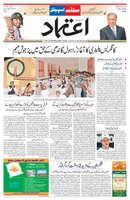Ateequllah is an established Urdu poet, who hails from Ujjain. He is known for his experimenting with ghazal and for his unique verses.
But some of his couplets appear shocking at first sight. It is possible that you may admire his craft. Similarly, you may also feel that the poet has deliberately composed slightly different poetry, in order to astonish, the reader.
Just read the three 'shair' which I have posted here and tell me what do you make out of them. The couplets are posted in both Urdu as well as Roman transliteration, for the benefit of readers.
میں ایک کانچ کا پر تولتا پرندہ
اڑان بھر نہ سکا اور چھن سے ٹوٹ گیا
main ek kaanch ka par taulta parindaa
uRaan bhar na saka aur chhan se TuuT gayaa
طلوع ہوتے دن کی پیٹھ پر چڑھ کر
سیاہ دیو میری ہڈیاں چباتا ہے
tuluu hote hue din kii piith par chaRh kar
siyaah deo meri haDDiyaaN chabaataa hai
وہ سنگ پاش ازیت کی تاب لا نہ سکا
میں اپنی چیخ میں پیوست ہو کے گونج اٹھا
woh sang-paash aziyat ki taab laa na sakaa
main apnii chiiKh meN paiwast ho ke guunj uThaa
But some of his couplets appear shocking at first sight. It is possible that you may admire his craft. Similarly, you may also feel that the poet has deliberately composed slightly different poetry, in order to astonish, the reader.
Just read the three 'shair' which I have posted here and tell me what do you make out of them. The couplets are posted in both Urdu as well as Roman transliteration, for the benefit of readers.
میں ایک کانچ کا پر تولتا پرندہ
اڑان بھر نہ سکا اور چھن سے ٹوٹ گیا
main ek kaanch ka par taulta parindaa
uRaan bhar na saka aur chhan se TuuT gayaa
طلوع ہوتے دن کی پیٹھ پر چڑھ کر
سیاہ دیو میری ہڈیاں چباتا ہے
tuluu hote hue din kii piith par chaRh kar
siyaah deo meri haDDiyaaN chabaataa hai
وہ سنگ پاش ازیت کی تاب لا نہ سکا
میں اپنی چیخ میں پیوست ہو کے گونج اٹھا
woh sang-paash aziyat ki taab laa na sakaa
main apnii chiiKh meN paiwast ho ke guunj uThaa






























